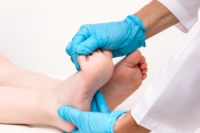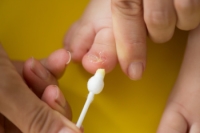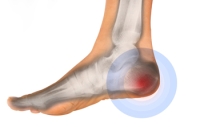
Blog (807)
The Perils of Working on Your Feet
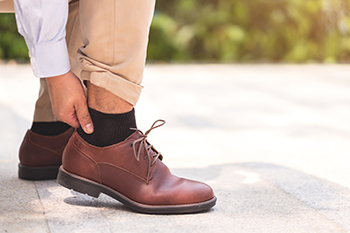
Working on your feet for extended periods can pose significant health risks. While physical activity is generally beneficial, excessive standing or walking can lead to various health issues. Surprisingly, approximately 75 percent of the global population works on their feet, especially in industries like retail, hospitality, healthcare, and manufacturing. Prolonged standing can cause fatigue, joint pain, and musculoskeletal disorders, contributing to conditions like plantar fasciitis and Achilles tendonitis. Additionally, it increases the risk of developing foot problems, such as bunions, corns, and calluses. To mitigate these risks, it is important to prioritize foot health. Wearing supportive footwear, taking regular breaks to elevate and stretch the feet, and using cushioned mats can help alleviate discomfort. Furthermore, engaging in foot exercises and maintaining a healthy weight can reduce strain on the feet. If you spend most of your workday on your feet and have persistent foot pain or complications, it is suggested that you seek guidance from a podiatrist. This foot doctor can provide personalized recommendations and treatments to alleviate discomfort and prevent long-term damage.
While working on the feet, it is important to take the proper care of them. For more information about working on your feet, contact Dr. Kenneth Donovan from Advanced Care Foot and Ankle. Our doctor will treat your foot and ankle needs.
Working on Your Feet
Standing on your feet for long periods of time can cause stress and pain in your feet. Your whole body may experience change in terms of posture, back pain, bunions, callouses and or plantar warts. There are ways to avoid these conditions with proper foot care, smart choices and correct posture.
Positive Changes
Negative heeled shoe – Choosing this shoe type places the heel slightly lower than the ball of the foot. These are great for overall foot health. Find shoes that fit you correctly.
Go barefoot – Our feet were not designed to be enclosed for all hours of the day. Try to periodically expose your feet to air.
Eliminate Pain
Foot Exercises – Performing simple exercises, incorporating yoga and doing stretches are beneficial. This will allow increased blood flow to the area and muscles of the foot.
Achilles tendon – Stretching the foot out flat on the floor will relax the calf muscles and tendon. These exercises can be performed almost anywhere. Make sure you add these exercises to your daily regimen.
With a little bit of this information and knowing more about foot health, you will notice changes. Foot stretches and proper footwear will help with pain and prevent further issues.
If you have any questions please feel free to contact one of our offices located in Warren, Livingston, and Toms River, NJ . We offer the newest diagnostic and treatment technologies for all your foot and ankle needs.
Childhood Rheumatoid Arthritis

Juvenile rheumatoid arthritis, or JRA, a chronic autoimmune disorder, occurs when the body's immune system mistakenly attacks its own tissues, leading to joint inflammation and damage. While the exact cause remains elusive, genetic predisposition and environmental factors likely play significant roles. Children with a family history of autoimmune diseases are at higher risk, although JRA can affect anyone. Symptoms may include joint stiffness, swelling, and pain, particularly in the feet and ankles. In some cases, JRA can lead to complications like joint deformities and growth problems. Diagnosing this condition involves a thorough evaluation of symptoms, medical history, and physical exams, often supplemented with blood tests and imaging studies. If your child has foot or ankle joint pain, it is strongly suggested that you schedule an appointment with a podiatrist who can collaborate with other relevant healthcare professionals to tailor a treatment plan that can relieve pain, maintain joint function, and prevent deformities.
Making sure that your children maintain good foot health is very important as they grow. If you have any questions, contact Dr. Kenneth Donovan of Advanced Care Foot and Ankle. Our doctor can provide the care you need to keep you pain-free and on your feet.
Keeping Children's Feet Healthy
Having healthy feet during childhood can help prevent medical problems later in life, namely in the back and legs. As children grow, their feet require different types of care. Here are some things to consider...
Although babies do not walk yet, it is still very important to take care of their feet.
Avoid putting tight shoes or socks on his or her feet.
Allow the baby to stretch and kick his or her feet to feel comfortable.
As a toddler, kids are now on the move and begin to develop differently. At this age, toddlers are getting a feel for walking, so don’t be alarmed if your toddler is unsteady or ‘walks funny’.
As your child gets older, it is important to teach them how to take care of their feet.
Show them proper hygiene to prevent infections such as fungus.
Be watchful for any pain or injury.
Have all injuries checked by a doctor as soon as possible.
Comfortable, protective shoes should always be worn, especially at play.
If you have any questions please feel free to contact one of our offices located in Warren, Livingston, and Toms River, NJ . We offer the newest diagnostic and treatment technologies for all your foot and ankle needs.
Arthritis Can Cause Pain in the Feet and Ankles
Dealing with Blisters Between the Toes

Blisters between the toes can be a real pain, whether they're caused by friction, insect bites, burns, or infections. These little pockets of fluid can make each step a challenge. Friction is often the main cause of blisters between the toes. When your toes rub against each other or your shoes, the skin becomes irritated and leads to blister formation. Other causes of blisters between the toes include insect bites, burns, and various infections. While most blisters will heal on their own within a week or two, it's essential to resist the urge to pop them. Breaking a blister can increase the risk of infection and prolong the healing process. Instead, keep the blister clean and covered with a bandage. If the blister is particularly painful or shows signs of infection, it's best to seek medical attention from a podiatrist. Preventing blisters between the toes starts with wearing properly fitting shoes and socks. Avoid walking long distances in new shoes, and be sure to change socks if they become damp. If you have persistent or severe blisters between the toes, it is suggested that you seek help from a podiatrist for relief.
Blisters are prone to making everyday activities extremely uncomfortable. If your feet are hurting, contact Dr. Kenneth Donovan of Advanced Care Foot and Ankle. Our doctor can provide the care you need to keep you pain-free and on your feet.
Foot Blisters
Foot blisters develop as a result of constantly wearing tight or ill-fitting footwear. This happens due to the constant rubbing from the shoe, which can often lead to pain.
What Are Foot Blisters?
A foot blister is a small fluid-filled pocket that forms on the upper-most layer of the skin. Blisters are filled with clear fluid and can lead to blood drainage or pus if the area becomes infected.
How Do Blisters Form?
Blisters on the feet are often the result of constant friction of skin and material, usually by shoe rubbing. Walking in sandals, boots, or shoes that don’t fit properly for long periods of time can result in a blister. Having consistent foot moisture and humidity can easily lead to blister formation.
Prevention & Treatment
It is important to properly care for the affected area in order to prevent infection and ease the pain. Do not lance the blister and use a Band-Aid to provide pain relief. Also, be sure to keep your feet dry and wear proper fitting shoes. If you see blood or pus in a blister, seek assistance from a podiatrist.
If you have any questions, please feel free to contact one of our offices located in Warren, Livingston, and Toms River, NJ . We offer the newest diagnostic and treatment technologies for all your foot care needs.
Treating Ankle Sprains
 Ankle sprains are injuries that occur when the ligaments that support the ankle stretch beyond their limits or tear. These injuries are often caused by twisting the ankle during physical activities, such as sports or even walking on uneven surfaces. Treatment for ankle sprains ranges from conservative to more intensive approaches, depending on the severity of the sprain. Initial treatment for mild sprains typically includes rest and elevation to reduce swelling and pain. More severe sprains may require immobilization with a brace or cast to allow the ligaments to heal properly. Certain stretches may be recommended to restore ankle strength, flexibility, and balance, and prevent future sprains. In cases where the ligament damage is extensive and stability is compromised, surgical intervention may be considered to repair the ligaments. If you have sprained your ankle, it is suggested that you promptly schedule an appointment with a podiatrist to get the right treatment.
Ankle sprains are injuries that occur when the ligaments that support the ankle stretch beyond their limits or tear. These injuries are often caused by twisting the ankle during physical activities, such as sports or even walking on uneven surfaces. Treatment for ankle sprains ranges from conservative to more intensive approaches, depending on the severity of the sprain. Initial treatment for mild sprains typically includes rest and elevation to reduce swelling and pain. More severe sprains may require immobilization with a brace or cast to allow the ligaments to heal properly. Certain stretches may be recommended to restore ankle strength, flexibility, and balance, and prevent future sprains. In cases where the ligament damage is extensive and stability is compromised, surgical intervention may be considered to repair the ligaments. If you have sprained your ankle, it is suggested that you promptly schedule an appointment with a podiatrist to get the right treatment.
Although ankle sprains are common, they aren’t always minor injuries. If you need your ankle injury looked at, contact Dr. Kenneth Donovan from Advanced Care Foot and Ankle. Our doctor can provide the care you need to keep you pain-free and on your feet.
How Does an Ankle Sprain Occur?
Ankle sprains are the result of a tear in the ligaments within the ankle. These injuries may happen when you make a rapid shifting movement while your foot is planted. A less common way to sprain your ankle is when your ankle rolls inward while your foot turns outward.
What Are the Symptoms?
- Pain at the sight of the tear
- Bruising/Swelling
- Ankle area is tender to touch
- In severe cases, may hear/feel something tear
- Skin discoloration
Preventing a Sprain
- Wearing appropriate shoes for the occasion
- Stretching before exercises and sports
- Knowing your limits
Treatment of a Sprain
In many cases, the RICE method (Rest, Ice, Compression, and Elevate) is used to treat ankle sprains. However, you should see a podiatrist to see which treatment option would work best with your injury. In severe cases, surgery may be required.
It is important to ask your doctor about rehab options after you receive treatment for your injury. Stretching, strength training, and balance exercises may help the ankle heal while also preventing further injury.
If you have any questions, please feel free to contact one of our offices located in Warren, Livingston, and Toms River, NJ . We offer the newest diagnostic and treatment technologies for all your foot care needs.
Types and Causes of Foot Corns

Corns on the feet are small, yet bothersome, skin formations that can cause significant pain if left untreated. Foot corns, which are composed of layers of dead skin cells, typically appear as thick, circular, raised areas of skin. They commonly develop on, near, or between the toes, below the toenail bed, or on the sole of the feet. The three primary types of foot corns are hard corns, soft corns, and seed corns. Regardless of their type, foot corns can cause discomfort, pain, and a burning sensation, particularly when wearing shoes or walking barefoot. Foot corns develop from excessive pressure or friction on the foot. Causes include wearing tight or ill-fitting shoes, prolonged standing, and walking or running barefoot. It's a good idea to address foot corns promptly and effectively to prevent complications. A podiatrist can offer personalized treatment options, including professional corn removal techniques and recommendations for footwear modifications. If you are experiencing the discomfort of corns on the foot, it is suggested that you schedule an appointment with a podiatrist to determine the type of corn and its proper treatment.
Corns can make walking very painful and should be treated immediately. If you have questions regarding your feet and ankles, contact Dr. Kenneth Donovan of Advanced Care Foot and Ankle. Our doctor will treat your foot and ankle needs.
Corns: What Are They? And How Do You Get Rid of Them?
Corns are thickened areas on the skin that can become painful. They are caused by excessive pressure and friction on the skin. Corns press into the deeper layers of the skin and are usually round in shape.
Ways to Prevent Corns
There are many ways to get rid of painful corns such as:
- Wearing properly fitting shoes that have been measured by a professional
- Wearing shoes that are not sharply pointed or have high heels
- Wearing only shoes that offer support
Treating Corns
Although most corns slowly disappear when the friction or pressure stops, this isn’t always the case. Consult with your podiatrist to determine the best treatment option for your case of corns.
If you have any questions please feel free to contact one of our offices located in Warren, Livingston, and Toms River, NJ . We offer the newest diagnostic and treatment technologies for all your foot and ankle needs.
Gout Pain Can Be Managed
Removing a Bone Spur on the Big Toe
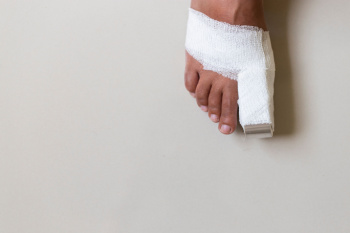
A surgical procedure aimed at relieving pain from bone spurs on the top of the big toe is called a cheilectomy. The pain is the result of arthritis that also causes stiffness in the big toe, termed hallux rigidus. Typically considered after non-surgical interventions, a cheilectomy involves the careful removal of bone spurs to alleviate discomfort and improve range of motion. Whether performed under general or local anesthesia, the procedure usually allows for a same-day operation. Following surgery, treatment often starts with gentle toe movements and stretching exercises to prevent stiffness. The recovery period typically spans six to eight weeks. While individual recovery time may vary, the primary goal of restoring function and alleviating pain are the focus. If you have persistent pain and limited mobility in your big toe, it is suggested that you schedule an appointment with a podiatrist for an exam, diagnosis, and personalized treatment plan, which may include surgery.
Foot surgery is sometimes necessary to treat a foot ailment. To learn more, contact Dr. Kenneth Donovan of Advanced Care Foot and Ankle. Our doctor will assist you with all of your foot and ankle needs.
When Is Surgery Necessary?
Foot and ankle surgery is generally reserved for cases in which less invasive, conservative procedures have failed to alleviate the problem. Some of the cases in which surgery may be necessary include:
- Removing foot deformities like bunions and bone spurs
- Severe arthritis that has caused bone issues
- Cosmetic reconstruction
What Types of Surgery Are There?
The type of surgery you receive will depend on the nature of the problem you have. Some of the possible surgeries include:
- Bunionectomy for painful bunions
- Surgical fusion for realignment of bones
- Neuropathy decompression surgery to treat nerve damage
Benefits of Surgery
Although surgery is usually a last resort, it can provide more complete pain relief compared to non-surgical methods and may allow you to finally resume full activity.
Surgical techniques have also become increasingly sophisticated. Techniques like endoscopic surgery allow for smaller incisions and faster recovery times.
If you have any questions please feel free to contact one of our offices located in Warren, Livingston, and Toms River, NJ . We offer the newest diagnostic and treatment technologies for all your foot and ankle needs.
Podiatrists Effectively Treat Ingrown Toenails
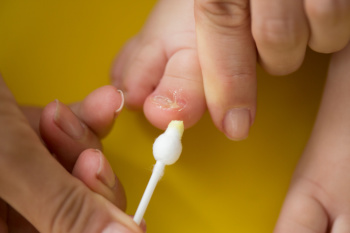 Podiatrists specialize in treating foot conditions, including the common yet painful issue of ingrown toenails. These occur when the edge of a toenail grows into the surrounding skin, causing discomfort, redness, and even infection. When treating an ingrown toenail, a podiatrist may start with conservative treatments, such as properly trimming the nail, lifting it from the skin, and recommending appropriate footwear to alleviate pressure. In cases where the ingrown toenail is recurrent or severe, a podiatrist may perform a minor surgical procedure under local anesthesia to remove part of the nail. This professional intervention not only addresses the immediate pain and infection but can also prevent recurrence of ingrown nails in that area. Patients can usually return to their daily activities quickly and comfortably, with minimal risk of complications. If you are suffering from an ingrown toenail, it is suggested that you consult a podiatrist for treatment.
Podiatrists specialize in treating foot conditions, including the common yet painful issue of ingrown toenails. These occur when the edge of a toenail grows into the surrounding skin, causing discomfort, redness, and even infection. When treating an ingrown toenail, a podiatrist may start with conservative treatments, such as properly trimming the nail, lifting it from the skin, and recommending appropriate footwear to alleviate pressure. In cases where the ingrown toenail is recurrent or severe, a podiatrist may perform a minor surgical procedure under local anesthesia to remove part of the nail. This professional intervention not only addresses the immediate pain and infection but can also prevent recurrence of ingrown nails in that area. Patients can usually return to their daily activities quickly and comfortably, with minimal risk of complications. If you are suffering from an ingrown toenail, it is suggested that you consult a podiatrist for treatment.
Ingrown toenails may initially present themselves as a minor discomfort, but they may progress into an infection in the skin without proper treatment. For more information about ingrown toenails, contact Dr. Kenneth Donovan of Advanced Care Foot and Ankle. Our doctor can provide the care you need to keep you pain-free and on your feet.
Ingrown Toenails
Ingrown toenails are caused when the corner or side of a toenail grows into the soft flesh surrounding it. They often result in redness, swelling, pain, and in some cases, infection. This condition typically affects the big toe and may recur if it is not treated properly.
Causes
- Improper toenail trimming
- Genetics
- Improper shoe fitting
- Injury from pedicures or nail picking
- Abnormal gait
- Poor hygiene
You are more likely to develop an ingrown toenail if you are obese, have diabetes, arthritis, or have any fungal infection in your nails. Additionally, people who have foot or toe deformities are at a higher risk of developing an ingrown toenail.
Symptoms
Some symptoms of ingrown toenails are redness, swelling, and pain. In rare cases, there may be a yellowish drainage coming from the nail.
Treatment
Ignoring an ingrown toenail can have serious complications. Infections of the nail border can progress to a deeper soft-tissue infection, which can then turn into a bone infection. You should always speak with your podiatrist if you suspect you have an ingrown toenail, especially if you have diabetes or poor circulation.
If you have any questions, please feel free to contact one of our offices located in Warren, Livingston, and Toms River, NJ . We offer the newest diagnostic and treatment technologies for all your foot care needs.
Diagnosis of Conditions Causing Heel Pain
 Diagnosing the cause of heel pain usually involves a comprehensive approach to identify the underlying issue accurately. First, a podiatrist will conduct a detailed medical history and physical examination, focusing on the foot to assess pain location, tenderness, and the presence of any swelling or abnormalities. The doctor may ask about the type of pain experienced, its onset, and any activities that exacerbate or relieve it. To further pinpoint the cause of heel pain, imaging tests such as X-rays, MRI scans, or ultrasounds may be utilized. These tools help a podiatrist visualize the internal structure of the foot, revealing issues like plantar fasciitis, heel spurs, or other soft tissue injuries. In certain cases, blood tests might be ordered to rule out systemic conditions, such as arthritis or gout, that can cause heel pain. Through this process, podiatrists can determine the specific cause of heel pain, allowing them to devise a targeted treatment plan that addresses the root of the problem. If you are suffering from heel pain, it is suggested that you contact a podiatrist today to begin the diagnostic process.
Diagnosing the cause of heel pain usually involves a comprehensive approach to identify the underlying issue accurately. First, a podiatrist will conduct a detailed medical history and physical examination, focusing on the foot to assess pain location, tenderness, and the presence of any swelling or abnormalities. The doctor may ask about the type of pain experienced, its onset, and any activities that exacerbate or relieve it. To further pinpoint the cause of heel pain, imaging tests such as X-rays, MRI scans, or ultrasounds may be utilized. These tools help a podiatrist visualize the internal structure of the foot, revealing issues like plantar fasciitis, heel spurs, or other soft tissue injuries. In certain cases, blood tests might be ordered to rule out systemic conditions, such as arthritis or gout, that can cause heel pain. Through this process, podiatrists can determine the specific cause of heel pain, allowing them to devise a targeted treatment plan that addresses the root of the problem. If you are suffering from heel pain, it is suggested that you contact a podiatrist today to begin the diagnostic process.
Many people suffer from bouts of heel pain. For more information, contact Dr. Kenneth Donovan of Advanced Care Foot and Ankle. Our doctor can provide the care you need to keep you pain-free and on your feet.
Causes of Heel Pain
Heel pain is often associated with plantar fasciitis. The plantar fascia is a band of tissues that extends along the bottom of the foot. A rip or tear in this ligament can cause inflammation of the tissue.
Achilles tendonitis is another cause of heel pain. Inflammation of the Achilles tendon will cause pain from fractures and muscle tearing. Lack of flexibility is also another symptom.
Heel spurs are another cause of pain. When the tissues of the plantar fascia undergo a great deal of stress, it can lead to ligament separation from the heel bone, causing heel spurs.
Why Might Heel Pain Occur?
- Wearing ill-fitting shoes
- Wearing non-supportive shoes
- Weight change
- Excessive running
Treatments
Heel pain should be treated as soon as possible for immediate results. Keeping your feet in a stress-free environment will help. If you suffer from Achilles tendonitis or plantar fasciitis, applying ice will reduce the swelling. Stretching before an exercise like running will help the muscles. Using all these tips will help make heel pain a condition of the past.
If you have any questions please contact one of our offices located in Warren, Livingston, and Toms River, NJ . We offer the newest diagnostic and treatment technologies for all your foot and ankle needs.

